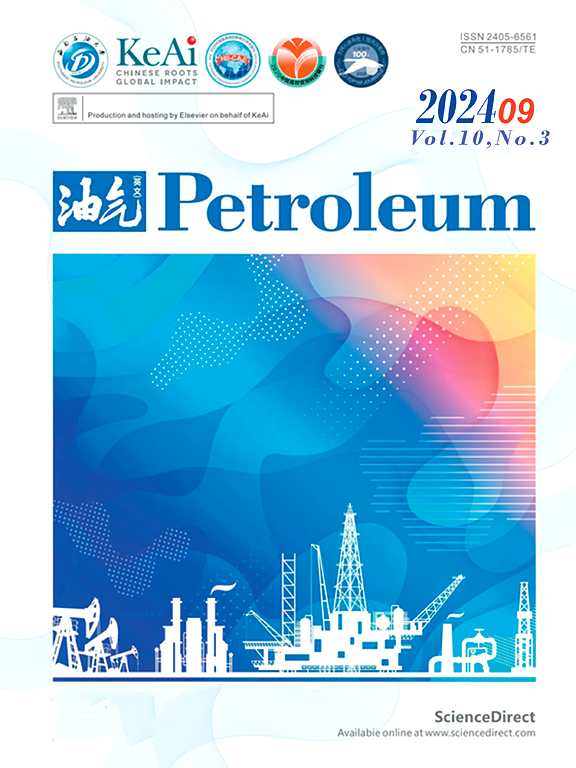Exploring hydrocarbon potential with 3D modeling techniques: Lower Cretaceous formations in Abu Sennan field, north Western Desert
IF 4.2
Q2 ENERGY & FUELS
引用次数: 0
Abstract
The northern portion of the Egyptian Western Desert is a very promising oil-producing province. The Abu Roash and Bahariya formations in Abu Sennan Field have a diverse lithological composition, leading to variances in reservoir continuity both horizontally and vertically. The reservoir heterogeneity problem is addressed by utilizing datasets derived from five wells and 3D seismic data that covers the full region of Abu Sennan. The lithology and reservoir levels were determined using geophysical well data. The investigated formations consist of sandstone, carbonate, and shale. The “E” and “G” members of the Abu Roash Formation, in addition to the Bahariya Formation, have the highest potential for containing hydrocarbons. Abu Roash E has a range of net pay from 17–47 m, shale volume ranging from 17% to 36%, effective porosity ranging between 20% and 26%, and oil saturation ranging between 49% and 77%. The Abu Roash “G” has a net pay range of 7–34 m, a shale content ranging from 5% to 42%, an effective porosity between 10% and 24%, and a hydrocarbon saturation ranging from 46% to 60%. The Bahariya Formation has a vertical thickness of 12–62 m, with a percentage of shale ranging from 16% to 44%. The formation also exhibits an effective porosity ranging from 15% to 26% and an oil saturation ranging between 46% and 77%. Analyzed 3D seismic data were utilized to create depth-structure maps. Seismic data interpretation and petrophysical analysis enabled the creation of 3D models for the structures and reservoirs in the Abu Sennan region. The static models served as the main inputs for calculating the volumetrics and generating two additional interesting opportunities in the researched region. For the investigated reservoirs, the estimated stock tank oil in place was about 394, 216, 376, and 601 (×106 m3) for AR/E, AR/F, AR/G, and Upper Baharyia, respectively. The projected volumes show the potential of the investigated intervals.
利用3D建模技术勘探油气潜力:西北沙漠Abu Sennan油田下白垩统地层
埃及西部沙漠的北部是一个非常有前途的产油省。Abu Sennan油田的Abu Roash和Bahariya组岩性组成多样,导致储层在水平和垂直方向上的连续性存在差异。利用5口井的数据集和覆盖Abu Sennan整个地区的三维地震数据,解决了储层非均质性问题。利用地球物理井资料确定了岩性和储层水平。研究的地层包括砂岩、碳酸盐和页岩。Abu Roash组的“E”和“G”成员,以及Bahariya组,具有最高的含烃潜力。Abu Roash E的净产层范围为17 ~ 47 m,页岩体积范围为17% ~ 36%,有效孔隙度范围为20% ~ 26%,含油饱和度范围为49% ~ 77%。Abu Roash“G”的净产层范围为7-34米,页岩含量为5% - 42%,有效孔隙度为10% - 24%,烃饱和度为46% - 60%。Bahariya组垂向厚度为12 ~ 62 m,页岩含量为16% ~ 44%。地层有效孔隙度为15% ~ 26%,含油饱和度为46% ~ 77%。利用分析后的三维地震数据绘制深度构造图。地震数据解释和岩石物理分析为Abu Sennan地区的构造和储层创建了三维模型。静态模型作为计算体积的主要输入,并在研究区域产生另外两个有趣的机会。对于所调查的储层,AR/E、AR/F、AR/G和Upper Baharyia的储油量分别约为394、216、376和601 (×106 m3)。预测的体积显示了所研究的层段的潜力。
本文章由计算机程序翻译,如有差异,请以英文原文为准。
求助全文
约1分钟内获得全文
求助全文
来源期刊

Petroleum
Earth and Planetary Sciences-Geology
CiteScore
9.20
自引率
0.00%
发文量
76
审稿时长
124 days
期刊介绍:
Examples of appropriate topical areas that will be considered include the following: 1.comprehensive research on oil and gas reservoir (reservoir geology): -geological basis of oil and gas reservoirs -reservoir geochemistry -reservoir formation mechanism -reservoir identification methods and techniques 2.kinetics of oil and gas basins and analyses of potential oil and gas resources: -fine description factors of hydrocarbon accumulation -mechanism analysis on recovery and dynamic accumulation process -relationship between accumulation factors and the accumulation process -analysis of oil and gas potential resource 3.theories and methods for complex reservoir geophysical prospecting: -geophysical basis of deep geologic structures and background of hydrocarbon occurrence -geophysical prediction of deep and complex reservoirs -physical test analyses and numerical simulations of reservoir rocks -anisotropic medium seismic imaging theory and new technology for multiwave seismic exploration -o theories and methods for reservoir fluid geophysical identification and prediction 4.theories, methods, technology, and design for complex reservoir development: -reservoir percolation theory and application technology -field development theories and methods -theory and technology for enhancing recovery efficiency 5.working liquid for oil and gas wells and reservoir protection technology: -working chemicals and mechanics for oil and gas wells -reservoir protection technology 6.new techniques and technologies for oil and gas drilling and production: -under-balanced drilling/gas drilling -special-track well drilling -cementing and completion of oil and gas wells -engineering safety applications for oil and gas wells -new technology of fracture acidizing
 求助内容:
求助内容: 应助结果提醒方式:
应助结果提醒方式:


